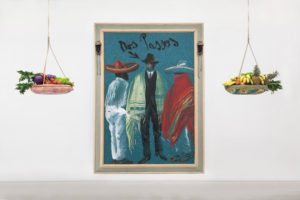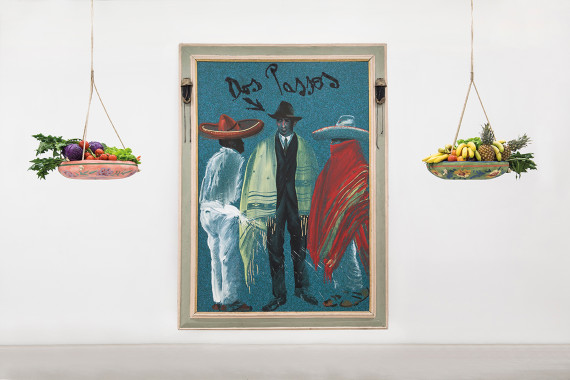While during the eighteenth century the young offsprings of European aristocracy undertook a long journey of education in the Old Continent to hone their political, cultural and artistic skills, the journey is still a key component of the poetic maturing of many contemporary artists who like to confront with civilization radically different from their own to renegotiate their creative thinking on the basis of this exchange of otherness. Enrico Astuni gallery devoted in recent months an extensive retrospective to Aldo Mondino (Turin 1938-2005), a tireless investigator of art languages and materials that during his frequent travels in the Mediterranean countries, South Americans and Middle Easterners found some of the deepest inspirations of his multifaceted work. The exhibition brings together works created over a period from mid-sixties and 2001 documenting the most important moments of his research and the continuous evolution of his distinctive and varied expressive and conceptual expression, always diluted and cooled by a playful approach and by ironic wordplay between title and subject.
The exhibition begins with a selection of works conceived as a fascinating immersion in the Mediterranean spirit that imbued the imagination of the Turin Master of magical and sleepy mystery and solemn lightness, entering into his figurative vocabulary a festive color gamut and an unrepeatable crowd of exotic characters in perfect symbiosis with the hats and the traditional dresses that underlie their kingship. In the Merchants series, inspired by a journey through the Moroccan souks, the artist portrays the sellers with cash and synthetic strokes by identifying them with the objects on display on the counter (balls of colored threads, skullcaps and bowls) directly applied to paintings. Assimilating reality and fantasy, painting enters the concrete world, exploring the countless variants in a narrative representation that supports the endless possibilities of exchange and osmosis between art and life. The tour continues with a series dedicated to Gnawa, a mystical brotherhood born from syncretism between Islam and animist cults whose followers practice hypnotic rituals linked to black magic to get in touch with the supernatural forces through music and dance. Deeply influenced by their energy at the first meeting in El-Fnaa square in Marrakech, Mondino purges their presence from the aura of danger around them recreating their traditional headgear as sculpture with crystals and shells and placing them in bright atmosphere in which artistic happiness neutralizes any suspicion. Drummers and rattles-players Gnawa during rituals consecrated to the possession dances are also the subjects of the two marble carpets featured in the exhibition (the first of which literally greets the visitor’s step at the entrance) which bear witness about the interest in this technique learned while attending Severini ‘s courses at the Ecole des Beaux-Arts.
By creating interaction with tradition and transgression, exoticism and cultural origins, reality and surrealism, music and dance are recurring motifs in his art and they can also be found in the different variants in which he had declined The Dance by Matisse in his youth. The synergistic relationship between these two disciplines comes back in La Danse des Jarres (1998), a painting from a large series focusing on dervishes, the ancient Islamic monks who dance go into trance. In front of the myopic but visionary Mondino’s eye the dancers with pitchers on the head (almost an extension of their spine) lose their natural connotation to take on the appearance of fantastic creatures that expand and sway in space merging with the surrounding landscape. The painted jugs counterpoint Dino Jarre (1997), an imaginative prehistoric skeleton consisting of a supple column of jars and ceramic amphorae inserted into one another and “held together by a (metal) soul”. The ascendant trend of the sculpture reminds that for Mondino art was the point of transition between the physical and the spiritual sphere in the same way for the dervishes were using dance and music to access the religious mysteries. Their mystical ecstasy left in the artist an unforgettable trace and in the Biennale of ’93 he invited twenty whirling dervishes with their musicians into the room dedicated to him to express the aspiration that painting was his way of praying and communicating his transcendent intuition to the public.
The mosaic returnes in Veronica (1999), portrait of a bullfighter, which stands for “the artist as a metaphor of man who can control the fear through beautiful gestures”, where traditional mosaic tiles are replaced by plaster imitations of chocolates covered with colored papers.The lush exotic setting that characterizes the main room of the exhibition becomes more conceptual in smaller halls that host the series Iznik (1995) of precious Turkish ceramics painted on glass as a collecting appropriation or Lying Carpets (1996), essays of extraordinary trompe l’oeil painting where the unusual support of fire-retardant industrial chipboard simulates warp and weft of oriental rugs in which the artist superimposed ornamental and decorative motifs taken from different traditions.
The exhibition continues with an exciting exploration of the gallery store usually inaccessible to the public, where between packaging and shelves on which you can see the names of some of the leading representatives of contemporary art, is placed the section dedicated to Mondino’s sculptural production as a complement of his plastic vision of painting. Boccioni’s Mother (1992) makes collide citing from the Matter framework of the Mattioli collection that inspired the face and a playful allusion to the progenitor’s large breasts consisting of two bowling balls. Busto Arsizio (1993) is a torso on which rests a big hat, whose ambiguous profile recalls some classical statuary mutilated by time and the nose of the Picasso sculpture, while Jugen Stilo (1992) is an elegant chandelier made with ballpoint pens Bic accompanied of plastic cap.
Aldo Mondino. Grand Tour contemporaneo.
curated by Achille Bonito Oliva e Vittoria Coen
2016, December 17 -2017, February 26
Galleria Enrico Astuni
Via Iacopo Barozzi, 3 Bologna

Aldo Mondino, Dos Passos, 1999. Olio su linoleum e materiali vari, cm. 300 x 213. Courtesy Galleria Enrico Astuni

Aldo Mondino, Maroc, 1999. Olio su linoleum, cm. 120 x 90. Courtesy Galleria Enrico Astuni

Aldo Mondino, Cammelli Fratelli, 1998. Olio su linoleum, cm. 120 x 140. Courtesy Galleria Enrico Astuni

Aldo Mondino, 4 Gnawa, 1996. Olio su linoleum, cm. 90 x 120. Courtesy Galleria Enrico Astuni

Aldo Mondino, Veronica, 1999. Gesso e carte colorate su legno, cm. 220 x 130. Courtesy Galleria Enrico Astuni
Graduated in art history at DAMS in Bologna, city where she continued to live and work, she specialized in Siena with Enrico Crispolti. Curious and attentive to the becoming of the contemporary, she believes in the power of art to make life more interesting and she loves to explore its latest trends through dialogue with artists, curators and gallery owners. She considers writing a form of reasoning and analysis that reconstructs the connection between the artist’s creative path and the surrounding context.







NO COMMENT